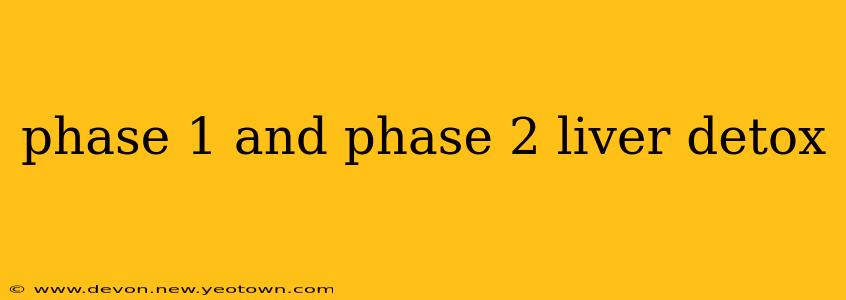The liver, often hailed as the body's unsung hero, works tirelessly to filter toxins, metabolize nutrients, and perform countless other essential functions. But what happens when this vital organ becomes burdened? Many turn to the concept of a "liver detox," aiming to support its natural cleansing processes. While there's no single magic bullet, understanding the two-phase detoxification system within the liver can guide you toward healthier choices. This isn't about a quick fix, but rather a journey towards optimizing your liver's inherent abilities. Let's embark on this journey together.
What is Phase 1 Liver Detoxification?
Imagine your liver as a highly sophisticated processing plant. Phase 1 detoxification is the initial sorting and preparation stage. Here, enzymes, primarily cytochrome P450 enzymes, modify toxins. Think of these enzymes as molecular engineers, altering the structure of harmful substances to make them more water-soluble. This transformation is crucial because it allows the body to more easily eliminate these modified toxins. However, it's important to note that this process can sometimes create intermediate metabolites—substances that may themselves be slightly toxic. This is where Phase 2 steps in.
What are the key enzymes involved in Phase 1 liver detox?
The Cytochrome P450 enzyme family is a large and diverse group, with various members handling different toxins. These enzymes are crucial for metabolizing a vast array of compounds, including medications, environmental toxins, and even naturally occurring substances in our food. The specifics of their activity are complex and vary based on factors like genetics and overall health.
What is Phase 2 Liver Detoxification?
Phase 2 is where the real magic happens. After the modifications in Phase 1, Phase 2 enzymes conjugate—or attach—molecules to the now-modified toxins. This process renders them even more water-soluble and less reactive, making their elimination significantly easier. Common conjugation reactions involve molecules like glutathione, glucuronic acid, and sulfate. These "tags" essentially mark the toxins for removal through the bile (into the intestines) or urine.
What are the key molecules involved in Phase 2 liver detox?
- Glutathione: This powerful antioxidant is essential for Phase 2 detoxification, neutralizing free radicals and helping to eliminate toxins.
- Glucuronic acid: This molecule attaches to many different toxins, making them easier to excrete.
- Sulfate: Another crucial conjugating molecule that helps prepare toxins for elimination.
How can I support my liver's natural detoxification processes?
Supporting your liver's detoxification isn't about a quick fix; it's about adopting a lifestyle that promotes its optimal function. Here's how:
- Eat a nutrient-rich diet: Focus on whole, unprocessed foods, including plenty of fruits, vegetables, and fiber. These provide essential nutrients crucial for both phases of detoxification.
- Hydration is key: Water is essential for flushing out toxins, assisting both the liver and kidneys in their elimination efforts.
- Manage stress: Chronic stress can negatively impact liver health. Incorporate stress-reducing techniques into your daily life, such as meditation, yoga, or spending time in nature.
- Prioritize sleep: Adequate sleep allows your body, including your liver, to repair and regenerate.
- Limit alcohol consumption: Excessive alcohol places a significant burden on the liver, hindering its ability to perform its functions efficiently.
- Avoid exposure to toxins: Where possible, minimize your exposure to environmental pollutants and harmful chemicals.
Are there specific foods or supplements that support liver detox?
While there isn't a "liver detox diet" backed by scientific consensus, incorporating foods rich in antioxidants and nutrients supporting Phase 1 and Phase 2 is beneficial. Cruciferous vegetables (broccoli, cauliflower, kale), foods rich in glutathione (avocado, asparagus), and those containing sulfur (onions, garlic) are often highlighted. However, always consult with a healthcare professional before starting any supplement regimen. Supplements should support the liver's natural processes, not replace a healthy lifestyle.
What are the signs of a poorly functioning liver?
A poorly functioning liver can manifest in various ways, from subtle changes to more serious symptoms. These can include fatigue, digestive issues, skin problems (like jaundice), and changes in urine color. If you experience any concerning symptoms, it’s crucial to consult a healthcare professional for proper diagnosis and treatment.
Can I do a liver cleanse or detox?
The term "liver cleanse" often refers to various commercial products promising rapid detoxification. However, the scientific evidence supporting these claims is generally lacking. Focusing on a healthy lifestyle, as described above, is far more effective and safer than resorting to potentially harmful "cleanses." Your liver possesses its own remarkable cleansing system—let's support it, not overwhelm it.
This journey towards a healthier liver isn't a sprint; it's a marathon. By understanding the intricate processes of Phase 1 and Phase 2 detoxification and making informed lifestyle choices, you can empower your liver to function optimally, supporting your overall well-being. Remember, always consult a healthcare professional before making significant dietary or lifestyle changes, especially if you have pre-existing health conditions.

